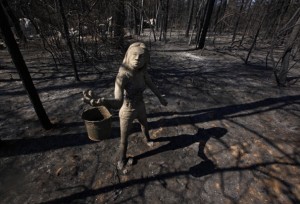After the Fires, Preparing for Floods

Erich Schlegel/Getty Images
A statue stands in front of the remnants of a burned down home outside Bastrop, Texas.
It seems counter-intuitive, but victims of wildfires in Texas should be thinking about the possibilities of flood, according to a new report by the Texas Division of Emergency Management and the Federal Emergency Management Agency.
While rain is a much-needed commodity in Texas these days, too much of it could have destructive consequences. Because of the wildfires that burned thousands of acres this year in Texas, “flood risk is higher,” the agencies say. “When fire burned away trees and other vegetation, healthy roots that soak up rainwater were lost,” the report says. “Storm runoff can cause severe erosion, mudslides and flooding.”
While Texas is under a devastating dry spell, flooding can be an issue in the state as well. On Memorial Day in 1981, flooding in Austin killed thirteen people and did $36 million in damages. Some parts of town got over ten inches of rain in four hours. And a 2006 rainfall of around Houston flooded 3,000 homes.
Those under the greatest risk of flooding are homes and land that were burned in the wildfires, but the report cautions that those downstream or below the burned areas are also at risk. “Such conditions are one reason flooding is America’s most common natural disaster,” the report says.
The solution? The agencies recommend flood insurance, as most homeowner’s insurance doesn’t cover flooding. But if you take the report’s advice, you’ll want to hurry. It takes thirty days for a policy to take effect. More information is available at www.floodsmart.gov.

